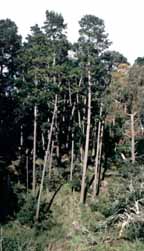
Looking into a stand of trees growing near Point Lobos, California [C.J. Earle].
Common Names
Monterey pine, insignis pine (2), radiata pine.Taxonomic notes
Syn: Pinus tuberculata D. Don; P. insignis Douglas ex Loudon (3<, 11).It hybridizes naturally with P. attenuata (P. × attenuradiata Stockwell & Righter; note that this name is was applied to an experimental hybrid specimen).
One variety, binata (Engelmann) Lemmon, the Guadalupe Island pine (= P. insignis var. binata Engelmann; P. muricata var. cedrosensis Howell; P. radiata var. cedrosensis (Howell) Silba) (5).
Description
Trees 15-30 m tall, 30-90 cm in diameter, contorted to straight; crown broadly conic, becoming rounded to flattened. Bark gray to reddish-brown, deeply V-furrowed, furrow bases red, ridges irregularly elongate-rectangular, their flattened surfaces scaly. Branches level to downcurved or ascending, poorly self-pruning; twigs slender, red-brown, sometimes glaucous, aging gray, rough. Buds ovoid to ovoid-cylindric, red-brown, ca. 1.5 cm, resinous. Needles 2 (var. binata) or 3 (type variety) per fascicle, spreading-ascending, persisting 3-4 years, (8)9-15(20) cm × 1.3-1.8(2) mm, straight, slightly twisted, deep yellow-green, all surfaces with fine stomatal lines, margins serrulate, apex conic-subulate; sheath (1)1.5-2 cm, base persistent. Pollen cones ellipsoid-cylindric, 10-15 mm, orange-brown. Seed cones maturing in February, 2 years after pollination, mostly serotinous and persistent 6-20(-40) years, numerous, solitary to whorled, spreading to recurved, curved, mostly asymmetric (usually symmetric in var. binata and occasionally so in var. radiata), ovoid before opening, broadly ovoid when open, 7-15 cm, yellow-brown, lustrous, scales rigid, stalks to 1cm; apophyses toward outer cone base mostly increasingly mammillate (but not in var. binata), those on inward cone side and middle and apex of cone more level; umbo central, mostly depressed, with small central boss or occasionally with slender, deciduous prickle. Seeds compressed-ellipsoid; body ca. 6 mm, dark brown; wing 20-30 mm. 2n=24 (2, 3, 12).Range
The type variety occurs naturally only at three localities in a fog belt on the coast of central California (at 30-400 m elevation; one in San Mateo and Santa Cruz counties, one in Monterey County, and one in San Luis Obispo County), while variety binata is found on Islas Guadalupe and Cedros, off the west coast of Baja California Norte, Mexico (at 600-1200 m elevation). Due to this rarity, the species is of conservation concern, with some natural populations receiving protection (2, 3, 5); var. binata is endangered, with under 100 senescent trees left on Guadalupe and a few thousand on Cedros (Lavery & Read in 10). USDA hardiness zone 8.Along the California coast it has escaped from cultivation, and from there into southern coastal Oregon it shows signs of naturalizing. It has been introduced as a timber tree in vast areas of New Zealand (where it is the most common tree), Australia, Chile, SW Europe and South Africa (2, 3, Lavery & Read in 10).
Big Tree
Diameter 213 cm, height 38 m, crown spread 28 m. Locality: Downing's Forest, CA (8).Even larger trees are now found in New Zealand, where a specimen 103 cm dbh and 64 m tall can be found in Atiamuri at NZ Forest Products, Ltd., and a tree 245 cm dbh and 49 m tall is recorded at Geraldine, South Canterbury (9).
Oldest
Dendrochronology
Ethnobotany
Observations
It can most easily be seen on the Monterey Peninsula, where it occurs on the hills in the interior of the peninsula. Most peninsular stands have suffered the depredations of axe and bulldozer, and nowadays the species is most comonly visited at Point Lobos State Park (6).Remarks
This is the most common pine in the southern hemisphere, where no pines are native (well, technically, Pinus merkusii crosses the Line in Sumatra).The three remaining native stands of this pine are infected and under threat of extinction from pitch canker, a fungal disease native to the southeast United States and found (in 1986) to have been introduced to California. When trees begin to die of the disease, they attract bark beetles which provide a pathway for infection of other trees. In some stands, 80-90% of trees are infected. If the disease is introduced in agroforestry areas dependent upon radiata pine, such as New Zealand, it could have catastrophic effects in those countries as well (13).
Its cones are serotinous, i.e. they remain closed until opened by the heat of a forest fire; the abundant seeds are then discharged to regenerate the burned forest. The cones may also burst open in hot weather (2).
Citations
(1) Silba 1986.(2) Little 1980.
(3) Kral in Flora of North America online.
(5) Perry 1991.
(6) Peattie 1950.
(8) American Forests 1996.
(9) Burstall & Sale 1984.
(10) Richardson 1998.
(11) C.I. Millar 1986. The Californian closed-cone pines; a taxonomic history and review. Taxon 35: 657-670.
(12) M.P. Frankis, personal communication 5-Mar-1999.
(13) Anonymous. 1999. Fungus threatens pines worldwide. American Forests, Autumn 1999, page 14.
See also:
Burns & Honkala 1990.
Elias 1987.
FEIS database.
This page co-edited with M.P. Frankis, Mar-1999.
back | Pinus | Pinaceae | home
This page is from the Gymnosperm Database
URL: http://www.geocities.com/~earlecj/pi/pin/radiata.htm
Edited by Christopher J. Earle
E-mail:earlecj@earthlink.com
Last modified on 29-Sep-1999